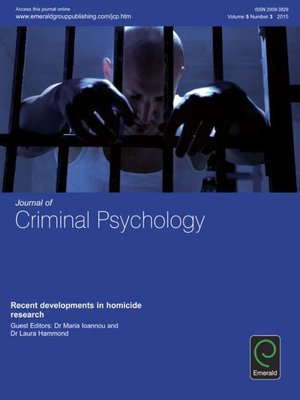Journal of Criminal Psychology, Volume 5, Number 3
ebook ∣ Recent Developments in Homicide Research · Journal of Criminal Psychology
By Daniel Boduszek

Sign up to save your library
With an OverDrive account, you can save your favorite libraries for at-a-glance information about availability. Find out more about OverDrive accounts.
Find this title in Libby, the library reading app by OverDrive.



Search for a digital library with this title
Title found at these libraries:
| Library Name | Distance |
|---|---|
| Loading... |
Homicidal behaviour is influenced by a complex interaction of behavioural, situational, and environmental factors that raise many challenging psychological questions. A large and continually-growing body of research has explored the crime of homicide, its epidemiology, victims and perpetrators. The area is developing rapidly, opening up new avenues of study. This e-book of the Journal of Criminal Psychology brings together an exciting array of chapters on homicidal behaviour, examining a wide range of issues including juvenile homicide perpetrators, school shootings, child homicide, homicide-suicide and differences in offence behaviours and victim characteristics between hard-to-solve one-off homicides and serial homicides. The range of chapters included in this e-book cover a wide range of aspects of homicidal behavior, reflecting the importance of - and the need for - applied research moving away from examining general homicide to specialised research focusing on subtypes of homicide and subgroups of homicide offenders.In this e-book, Hammond & Ioannou present one of the first detailed analyses of variations between child and adolescent homicide offenders in terms of personal history and background variables, victim characteristics, victim-offender relationships and method of killing. They show similar etiologies for the two groups, finding no significant differences in the ways in which juvenile homicide perpetrators of different ages commit their crimes. This has significant and far-reaching implications for the management and treatment of juvenile murderers, as well as notable implications for our understanding of the developmental processes underpinning the creation of a 'killer'. Sturup & Caman explore the phenomenon of homicide followed by suicide in a novel context; their detailed case study analysis of cases of homicide-suicide committed in Sweden between 2007 and 2009, conducted as part of one of the largest studies into Nordic homicide to date, offers a profile of this rare form of homicide. They provide base rates and reference figures that future research, conducted both in Sweden and around the world, will no doubt find invaluable. Ioannou, Hammond & Simpson take a novel approach to analyzing case material on school shootings in order to propose a model for differentiating school shooters on the basis of their characteristics. In doing so, they highlight a range of potential risk factors and motivational influences underlying different types of school shooting incident. Findings have a range of important implications, both for investigations and for the management/treatment of this extreme form of multiple homicide. Roach & Bryant explore in depth potential risk factors for becoming a perpetrator or victim of child homicide. Using a large and varied sample drawn from across England and Wales, they not only identify a range risk indicators which suggest themselves to be reliable and robust, but they also generate a number of risk profiles for both operational and interventional use. Finally, Pakkanen, Zappalà, Bosco, Berti & Santtila explore evidence for the existence of any distinct differences between serial and hard-to-solve one-off homicides, with the aim of determining whether the two can be reliably distinguished on the basis of offence behaviours and victim characteristics. They show that serial homicides are more likely to target strangers and prostitutes, to possess sexual elements, and to display evidence of forensic awareness on the part of the perpetrator, whereas one-off homicides tend to possess more traits indicative of impulsivity and expressivity. This is the first ever study to explicitly try to predict whether a homicide is an isolated case...







